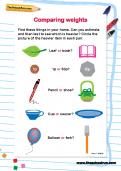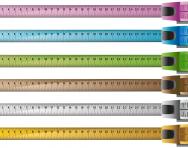Comparing weights
A Year 2 maths worksheet created by a teacher to help your child learn how to compare weights of two household objects to see which is the heaviest.
How do you compare weights in primary school?
Comparing weights in primary school is taught through a variety of interactive and hands-on methods to help children grasp the concept.
- One effective approach is using balance scales and digital scales, allowing children to visually and numerically compare the weights of different objects.
- Teachers also use everyday objects like apples, books, and pencils to make the lessons relatable. Activities such as guessing which object is heavier and then checking with a scale, sorting objects from lightest to heaviest, and setting up weight stations with different items and scales help reinforce these concepts.
- Visual aids like weight charts and illustrations of balance scales further aid understanding.
- Incorporating math skills is another key aspect, where children measure and record weights, compare numbers, and learn units of measurement such as grams and kilograms.
- Real-life contexts and story problems, like comparing weights in cooking or mailing packages, make the lessons more meaningful.
How will this Comparing weights worksheet help your Year 1 child?
This worksheet was created by an experienced educator with the aim of teaching your child about comparing weights in a fun and engaging way, using real world objects they can find at home. They must first estimate which object they think will be heavier, and then check (with scales you may have in the kitchen) to discover if they were correct.
For more Year 1 maths support, check out our hub page, or try a new challenge such as our Use string to measure worksheet.









